TOYOTA YARIS HYBRID 2012 Owners Manual
Manufacturer: TOYOTA, Model Year: 2012, Model line: YARIS HYBRID, Model: TOYOTA YARIS HYBRID 2012Pages: 704, PDF Size: 27.58 MB
Page 211 of 704
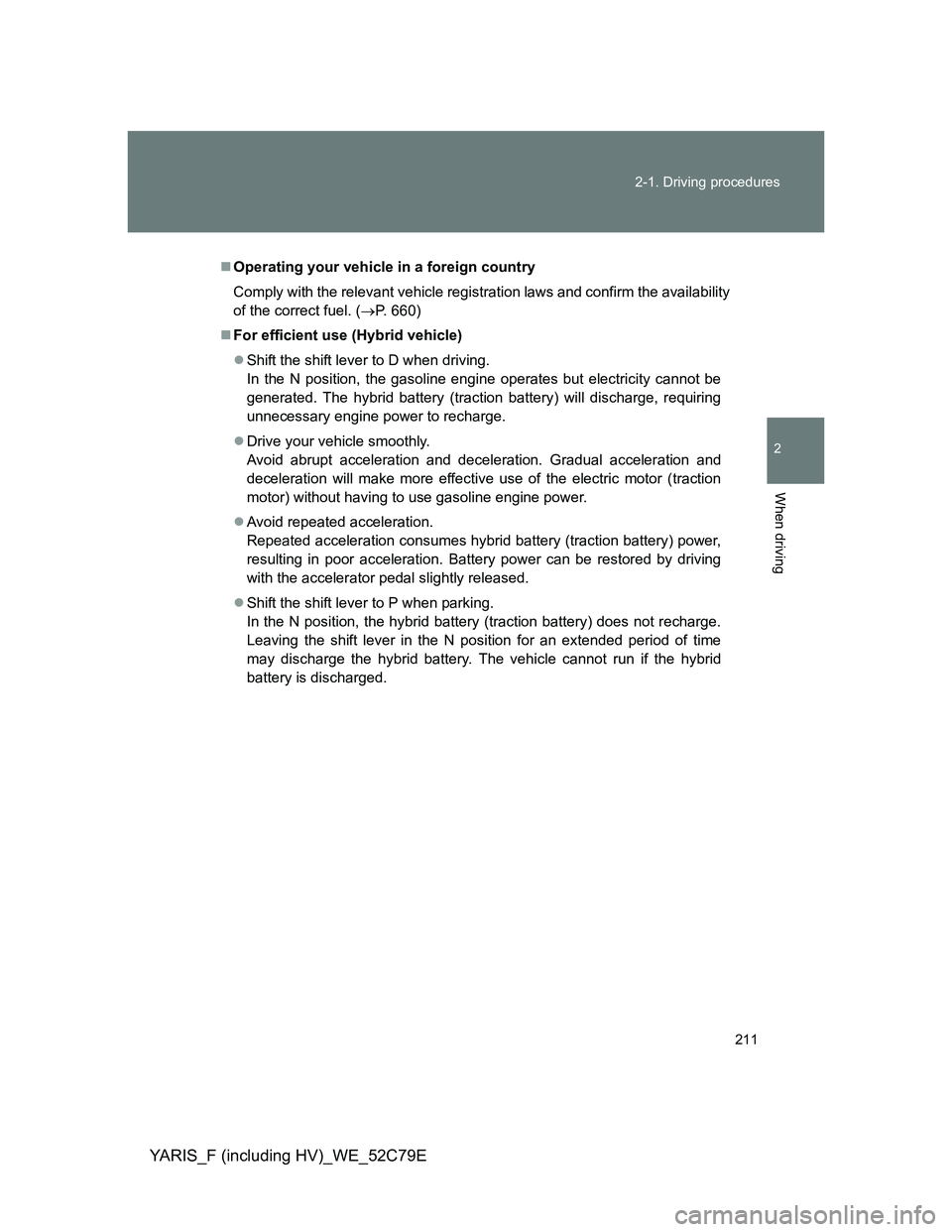
211 2-1. Driving procedures
2
When driving
YARIS_F (including HV)_WE_52C79E
Operating your vehicle in a foreign country
Comply with the relevant vehicle registration laws and confirm the availability
of the correct fuel. (P. 660)
For efficient use (Hybrid vehicle)
Shift the shift lever to D when driving.
In the N position, the gasoline engine operates but electricity cannot be
generated. The hybrid battery (traction battery) will discharge, requiring
unnecessary engine power to recharge.
Drive your vehicle smoothly.
Avoid abrupt acceleration and deceleration. Gradual acceleration and
deceleration will make more effective use of the electric motor (traction
motor) without having to use gasoline engine power.
Avoid repeated acceleration.
Repeated acceleration consumes hybrid battery (traction battery) power,
resulting in poor acceleration. Battery power can be restored by driving
with the accelerator pedal slightly released.
Shift the shift lever to P when parking.
In the N position, the hybrid battery (traction battery) does not recharge.
Leaving the shift lever in the N position for an extended period of time
may discharge the hybrid battery. The vehicle cannot run if the hybrid
battery is discharged.
Page 212 of 704
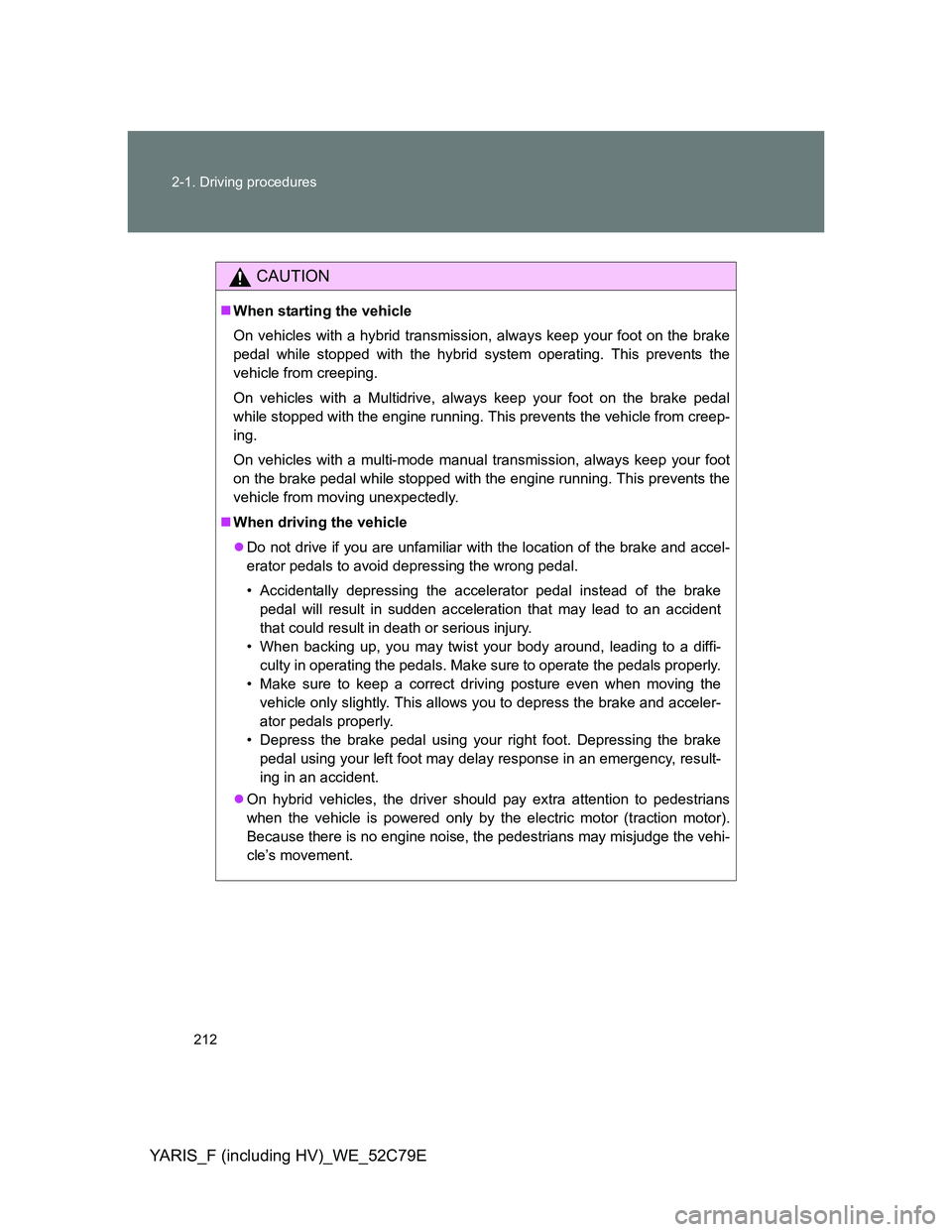
212 2-1. Driving procedures
YARIS_F (including HV)_WE_52C79E
CAUTION
When starting the vehicle
On vehicles with a hybrid transmission, always keep your foot on the brake
pedal while stopped with the hybrid system operating. This prevents the
vehicle from creeping.
On vehicles with a Multidrive, always keep your foot on the brake pedal
while stopped with the engine running. This prevents the vehicle from creep-
ing.
On vehicles with a multi-mode manual transmission, always keep your foot
on the brake pedal while stopped with the engine running. This prevents the
vehicle from moving unexpectedly.
When driving the vehicle
Do not drive if you are unfamiliar with the location of the brake and accel-
erator pedals to avoid depressing the wrong pedal.
• Accidentally depressing the accelerator pedal instead of the brake
pedal will result in sudden acceleration that may lead to an accident
that could result in death or serious injury.
• When backing up, you may twist your body around, leading to a diffi-
culty in operating the pedals. Make sure to operate the pedals properly.
• Make sure to keep a correct driving posture even when moving the
vehicle only slightly. This allows you to depress the brake and acceler-
ator pedals properly.
• Depress the brake pedal using your right foot. Depressing the brake
pedal using your left foot may delay response in an emergency, result-
ing in an accident.
On hybrid vehicles, the driver should pay extra attention to pedestrians
when the vehicle is powered only by the electric motor (traction motor).
Because there is no engine noise, the pedestrians may misjudge the vehi-
cle’s movement.
Page 213 of 704
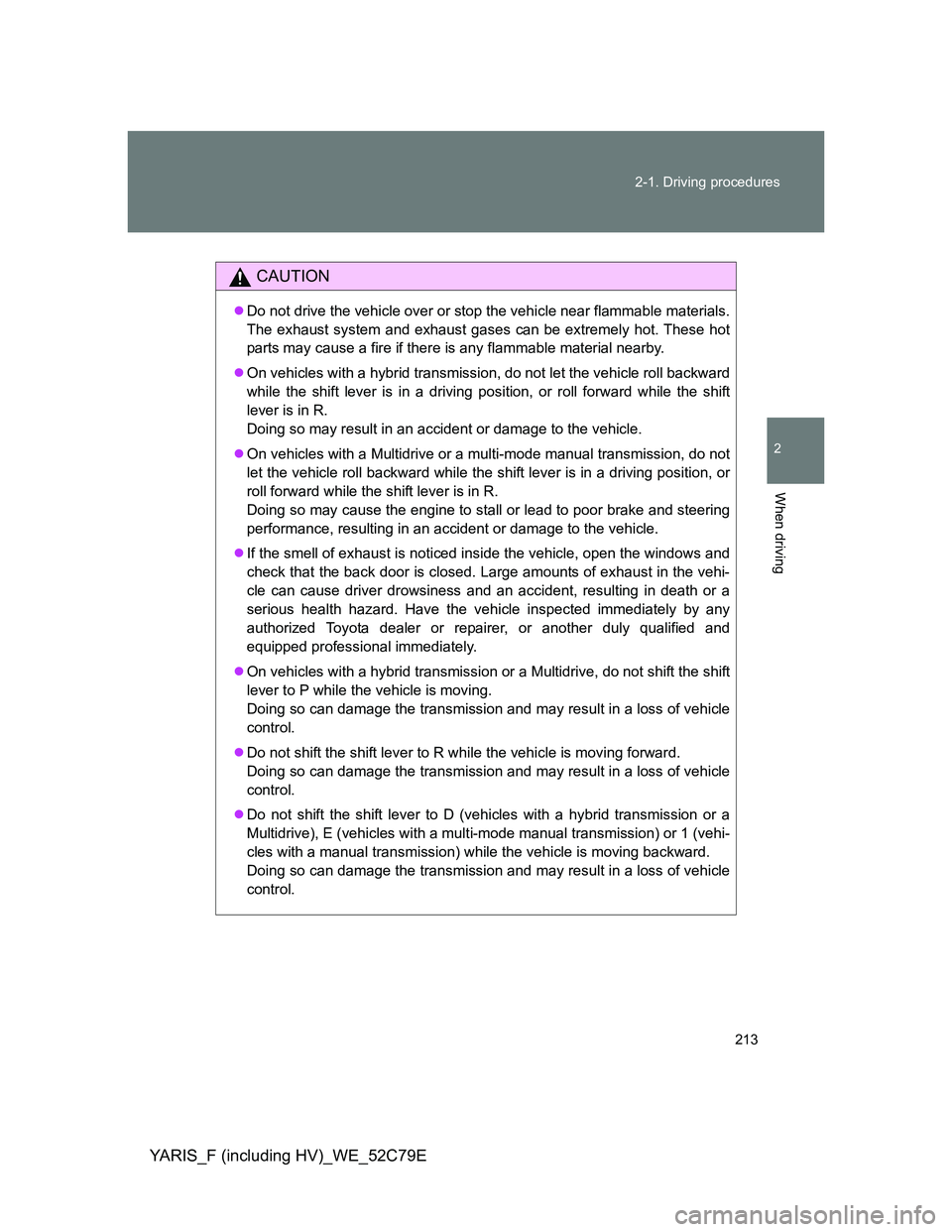
213 2-1. Driving procedures
2
When driving
YARIS_F (including HV)_WE_52C79E
CAUTION
Do not drive the vehicle over or stop the vehicle near flammable materials.
The exhaust system and exhaust gases can be extremely hot. These hot
parts may cause a fire if there is any flammable material nearby.
On vehicles with a hybrid transmission, do not let the vehicle roll backward
while the shift lever is in a driving position, or roll forward while the shift
lever is in R.
Doing so may result in an accident or damage to the vehicle.
On vehicles with a Multidrive or a multi-mode manual transmission, do not
let the vehicle roll backward while the shift lever is in a driving position, or
roll forward while the shift lever is in R.
Doing so may cause the engine to stall or lead to poor brake and steering
performance, resulting in an accident or damage to the vehicle.
If the smell of exhaust is noticed inside the vehicle, open the windows and
check that the back door is closed. Large amounts of exhaust in the vehi-
cle can cause driver drowsiness and an accident, resulting in death or a
serious health hazard. Have the vehicle inspected immediately by any
authorized Toyota dealer or repairer, or another duly qualified and
equipped professional immediately.
On vehicles with a hybrid transmission or a Multidrive, do not shift the shift
lever to P while the vehicle is moving.
Doing so can damage the transmission and may result in a loss of vehicle
control.
Do not shift the shift lever to R while the vehicle is moving forward.
Doing so can damage the transmission and may result in a loss of vehicle
control.
Do not shift the shift lever to D (vehicles with a hybrid transmission or a
Multidrive), E (vehicles with a multi-mode manual transmission) or 1 (vehi-
cles with a manual transmission) while the vehicle is moving backward.
Doing so can damage the transmission and may result in a loss of vehicle
control.
Page 214 of 704
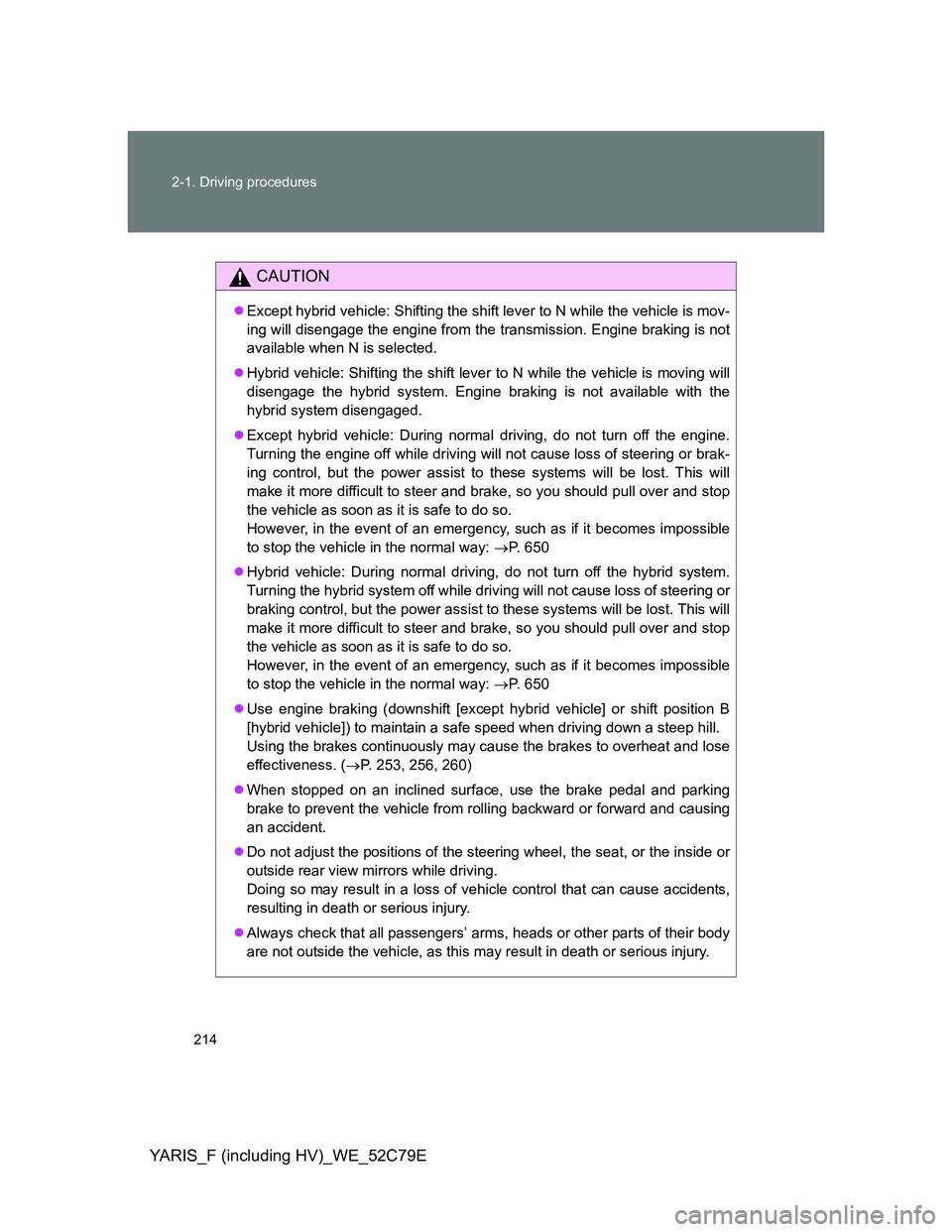
214 2-1. Driving procedures
YARIS_F (including HV)_WE_52C79E
CAUTION
Except hybrid vehicle: Shifting the shift lever to N while the vehicle is mov-
ing will disengage the engine from the transmission. Engine braking is not
available when N is selected.
Hybrid vehicle: Shifting the shift lever to N while the vehicle is moving will
disengage the hybrid system. Engine braking is not available with the
hybrid system disengaged.
Except hybrid vehicle: During normal driving, do not turn off the engine.
Turning the engine off while driving will not cause loss of steering or brak-
ing control, but the power assist to these systems will be lost. This will
make it more difficult to steer and brake, so you should pull over and stop
the vehicle as soon as it is safe to do so.
However, in the event of an emergency, such as if it becomes impossible
to stop the vehicle in the normal way: P. 650
Hybrid vehicle: During normal driving, do not turn off the hybrid system.
Turning the hybrid system off while driving will not cause loss of steering or
braking control, but the power assist to these systems will be lost. This will
make it more difficult to steer and brake, so you should pull over and stop
the vehicle as soon as it is safe to do so.
However, in the event of an emergency, such as if it becomes impossible
to stop the vehicle in the normal way: P. 650
Use engine braking (downshift [except hybrid vehicle] or shift position B
[hybrid vehicle]) to maintain a safe speed when driving down a steep hill.
Using the brakes continuously may cause the brakes to overheat and lose
effectiveness. (P. 253, 256, 260)
When stopped on an inclined surface, use the brake pedal and parking
brake to prevent the vehicle from rolling backward or forward and causing
an accident.
Do not adjust the positions of the steering wheel, the seat, or the inside or
outside rear view mirrors while driving.
Doing so may result in a loss of vehicle control that can cause accidents,
resulting in death or serious injury.
Always check that all passengers’ arms, heads or other parts of their body
are not outside the vehicle, as this may result in death or serious injury.
Page 215 of 704
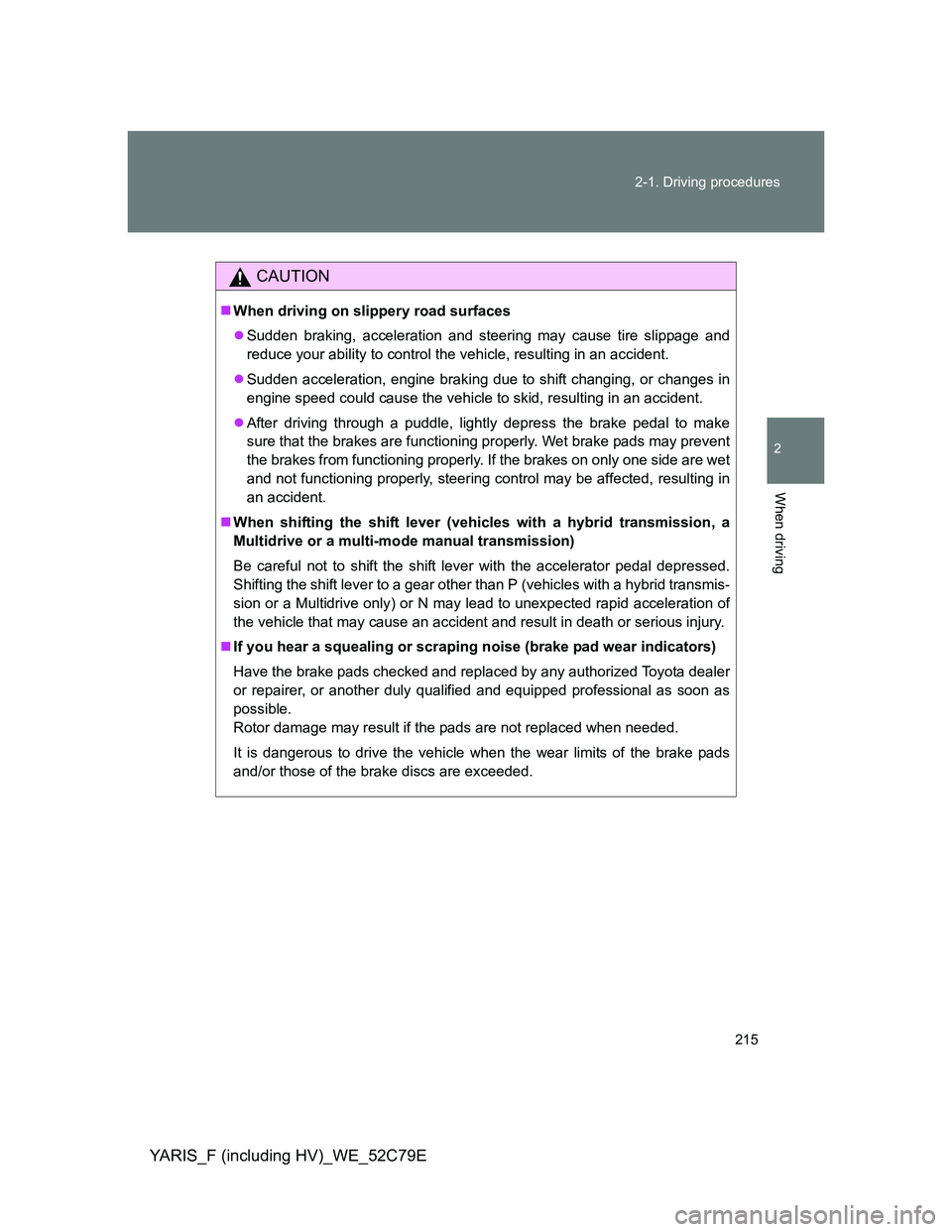
215 2-1. Driving procedures
2
When driving
YARIS_F (including HV)_WE_52C79E
CAUTION
When driving on slippery road surfaces
Sudden braking, acceleration and steering may cause tire slippage and
reduce your ability to control the vehicle, resulting in an accident.
Sudden acceleration, engine braking due to shift changing, or changes in
engine speed could cause the vehicle to skid, resulting in an accident.
After driving through a puddle, lightly depress the brake pedal to make
sure that the brakes are functioning properly. Wet brake pads may prevent
the brakes from functioning properly. If the brakes on only one side are wet
and not functioning properly, steering control may be affected, resulting in
an accident.
When shifting the shift lever (vehicles with a hybrid transmission, a
Multidrive or a multi-mode manual transmission)
Be careful not to shift the shift lever with the accelerator pedal depressed.
Shifting the shift lever to a gear other than P (vehicles with a hybrid transmis-
sion or a Multidrive only) or N may lead to unexpected rapid acceleration of
the vehicle that may cause an accident and result in death or serious injury.
If you hear a squealing or scraping noise (brake pad wear indicators)
Have the brake pads checked and replaced by any authorized Toyota dealer
or repairer, or another duly qualified and equipped professional as soon as
possible.
Rotor damage may result if the pads are not replaced when needed.
It is dangerous to drive the vehicle when the wear limits of the brake pads
and/or those of the brake discs are exceeded.
Page 216 of 704
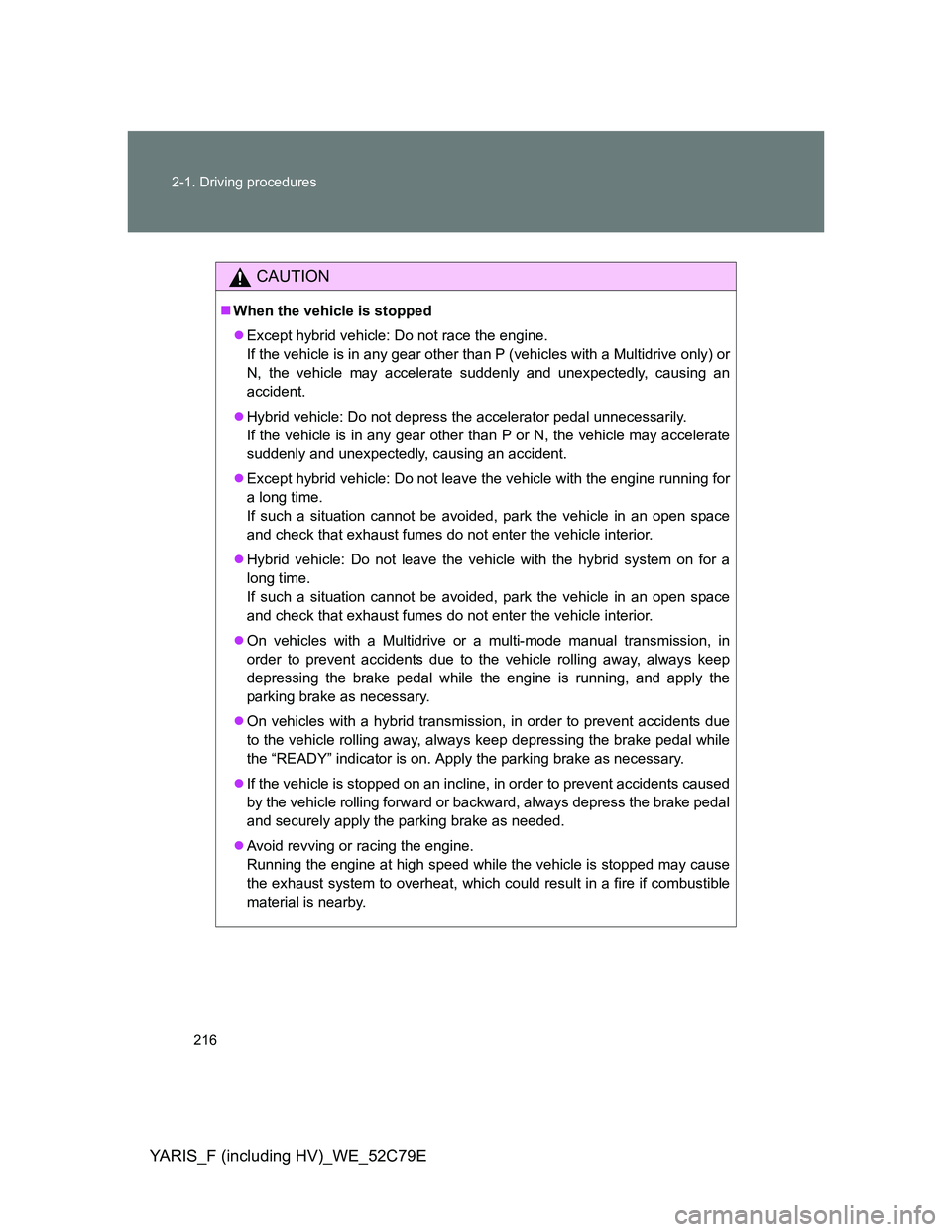
216 2-1. Driving procedures
YARIS_F (including HV)_WE_52C79E
CAUTION
When the vehicle is stopped
Except hybrid vehicle: Do not race the engine.
If the vehicle is in any gear other than P (vehicles with a Multidrive only) or
N, the vehicle may accelerate suddenly and unexpectedly, causing an
accident.
Hybrid vehicle: Do not depress the accelerator pedal unnecessarily.
If the vehicle is in any gear other than P or N, the vehicle may accelerate
suddenly and unexpectedly, causing an accident.
Except hybrid vehicle: Do not leave the vehicle with the engine running for
a long time.
If such a situation cannot be avoided, park the vehicle in an open space
and check that exhaust fumes do not enter the vehicle interior.
Hybrid vehicle: Do not leave the vehicle with the hybrid system on for a
long time.
If such a situation cannot be avoided, park the vehicle in an open space
and check that exhaust fumes do not enter the vehicle interior.
On vehicles with a Multidrive or a multi-mode manual transmission, in
order to prevent accidents due to the vehicle rolling away, always keep
depressing the brake pedal while the engine is running, and apply the
parking brake as necessary.
On vehicles with a hybrid transmission, in order to prevent accidents due
to the vehicle rolling away, always keep depressing the brake pedal while
the “READY” indicator is on. Apply the parking brake as necessary.
If the vehicle is stopped on an incline, in order to prevent accidents caused
by the vehicle rolling forward or backward, always depress the brake pedal
and securely apply the parking brake as needed.
Avoid revving or racing the engine.
Running the engine at high speed while the vehicle is stopped may cause
the exhaust system to overheat, which could result in a fire if combustible
material is nearby.
Page 217 of 704
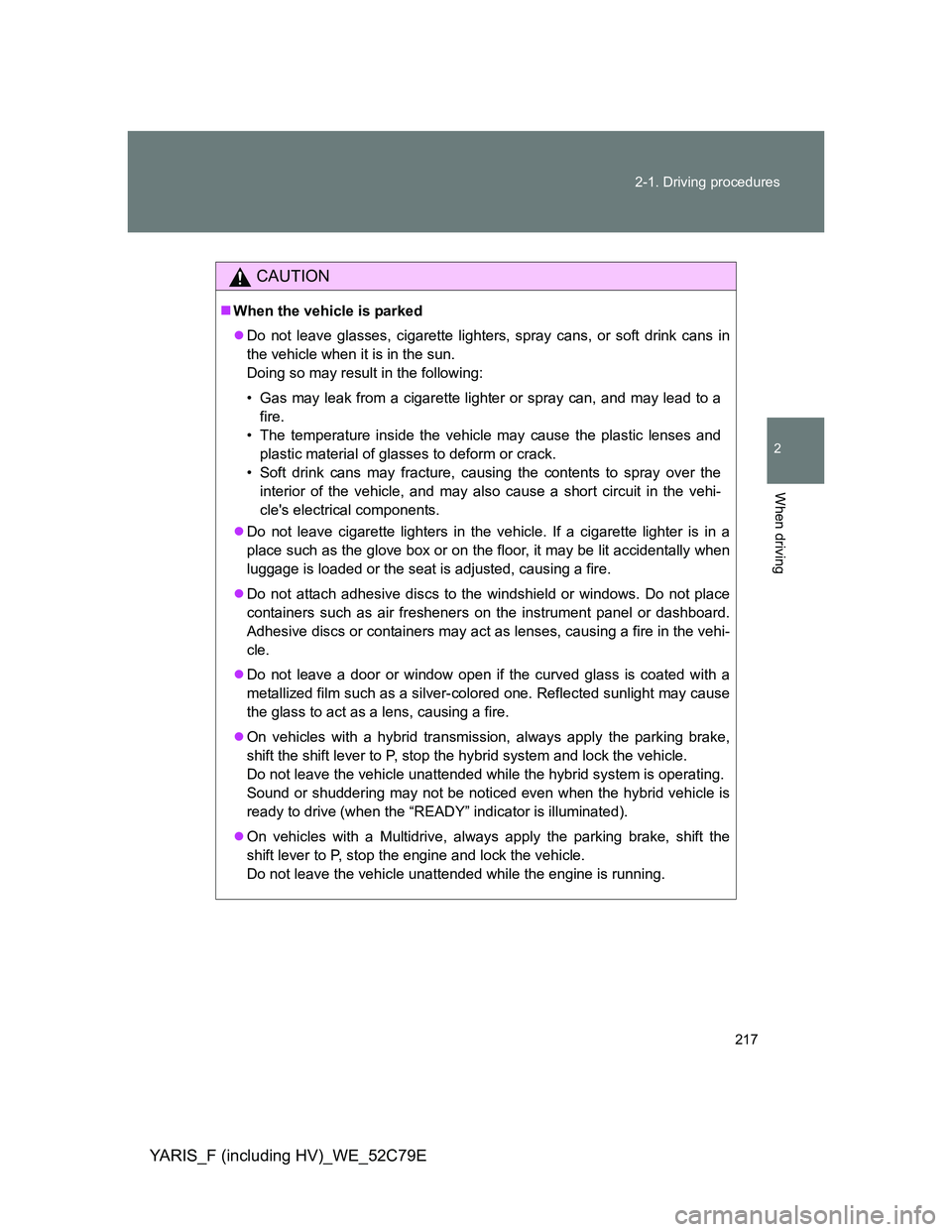
217 2-1. Driving procedures
2
When driving
YARIS_F (including HV)_WE_52C79E
CAUTION
When the vehicle is parked
Do not leave glasses, cigarette lighters, spray cans, or soft drink cans in
the vehicle when it is in the sun.
Doing so may result in the following:
• Gas may leak from a cigarette lighter or spray can, and may lead to a
fire.
• The temperature inside the vehicle may cause the plastic lenses and
plastic material of glasses to deform or crack.
• Soft drink cans may fracture, causing the contents to spray over the
interior of the vehicle, and may also cause a short circuit in the vehi-
cle's electrical components.
Do not leave cigarette lighters in the vehicle. If a cigarette lighter is in a
place such as the glove box or on the floor, it may be lit accidentally when
luggage is loaded or the seat is adjusted, causing a fire.
Do not attach adhesive discs to the windshield or windows. Do not place
containers such as air fresheners on the instrument panel or dashboard.
Adhesive discs or containers may act as lenses, causing a fire in the vehi-
cle.
Do not leave a door or window open if the curved glass is coated with a
metallized film such as a silver-colored one. Reflected sunlight may cause
the glass to act as a lens, causing a fire.
On vehicles with a hybrid transmission, always apply the parking brake,
shift the shift lever to P, stop the hybrid system and lock the vehicle.
Do not leave the vehicle unattended while the hybrid system is operating.
Sound or shuddering may not be noticed even when the hybrid vehicle is
ready to drive (when the “READY” indicator is illuminated).
On vehicles with a Multidrive, always apply the parking brake, shift the
shift lever to P, stop the engine and lock the vehicle.
Do not leave the vehicle unattended while the engine is running.
Page 218 of 704
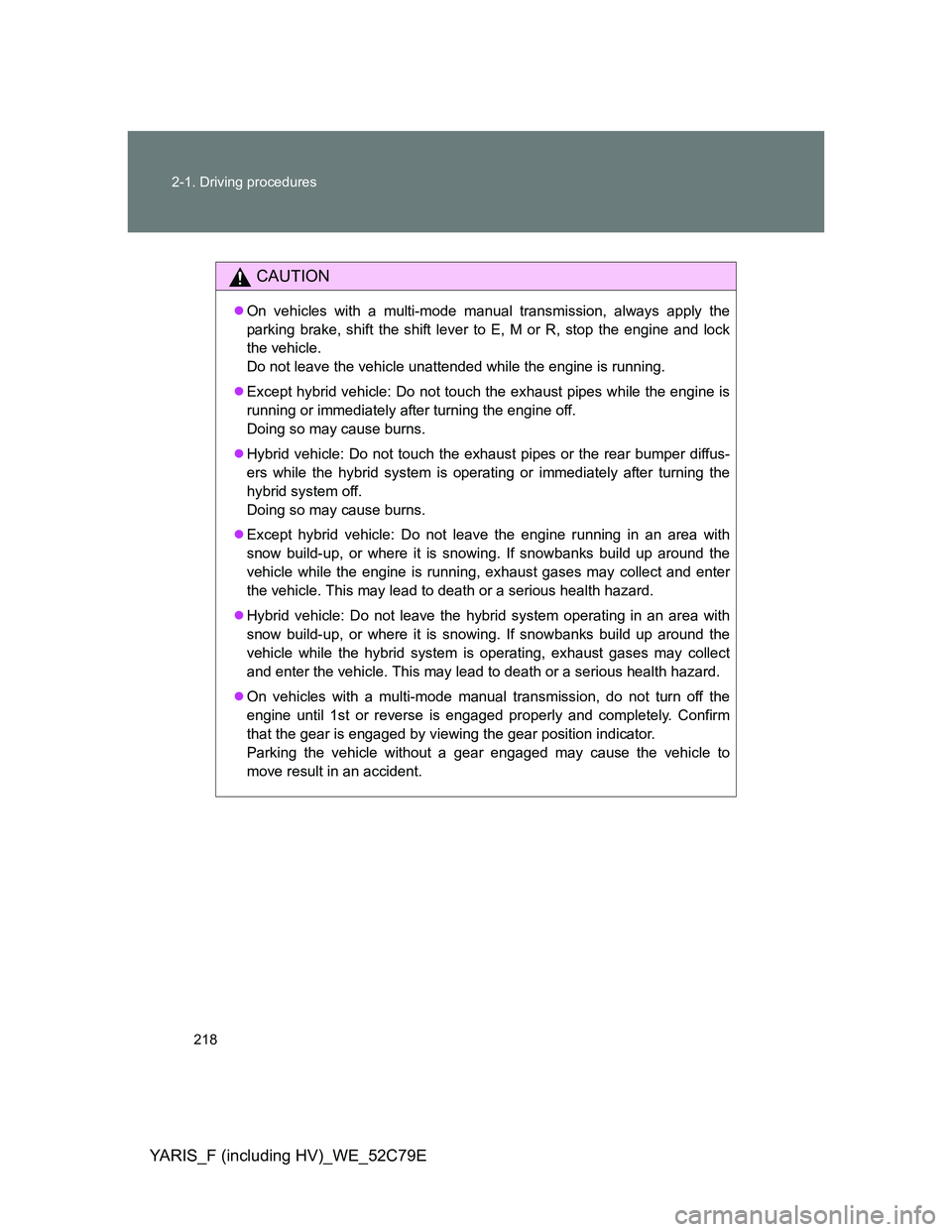
218 2-1. Driving procedures
YARIS_F (including HV)_WE_52C79E
CAUTION
On vehicles with a multi-mode manual transmission, always apply the
parking brake, shift the shift lever to E, M or R, stop the engine and lock
the vehicle.
Do not leave the vehicle unattended while the engine is running.
Except hybrid vehicle: Do not touch the exhaust pipes while the engine is
running or immediately after turning the engine off.
Doing so may cause burns.
Hybrid vehicle: Do not touch the exhaust pipes or the rear bumper diffus-
ers while the hybrid system is operating or immediately after turning the
hybrid system off.
Doing so may cause burns.
Except hybrid vehicle: Do not leave the engine running in an area with
snow build-up, or where it is snowing. If snowbanks build up around the
vehicle while the engine is running, exhaust gases may collect and enter
the vehicle. This may lead to death or a serious health hazard.
Hybrid vehicle: Do not leave the hybrid system operating in an area with
snow build-up, or where it is snowing. If snowbanks build up around the
vehicle while the hybrid system is operating, exhaust gases may collect
and enter the vehicle. This may lead to death or a serious health hazard.
On vehicles with a multi-mode manual transmission, do not turn off the
engine until 1st or reverse is engaged properly and completely. Confirm
that the gear is engaged by viewing the gear position indicator.
Parking the vehicle without a gear engaged may cause the vehicle to
move result in an accident.
Page 219 of 704
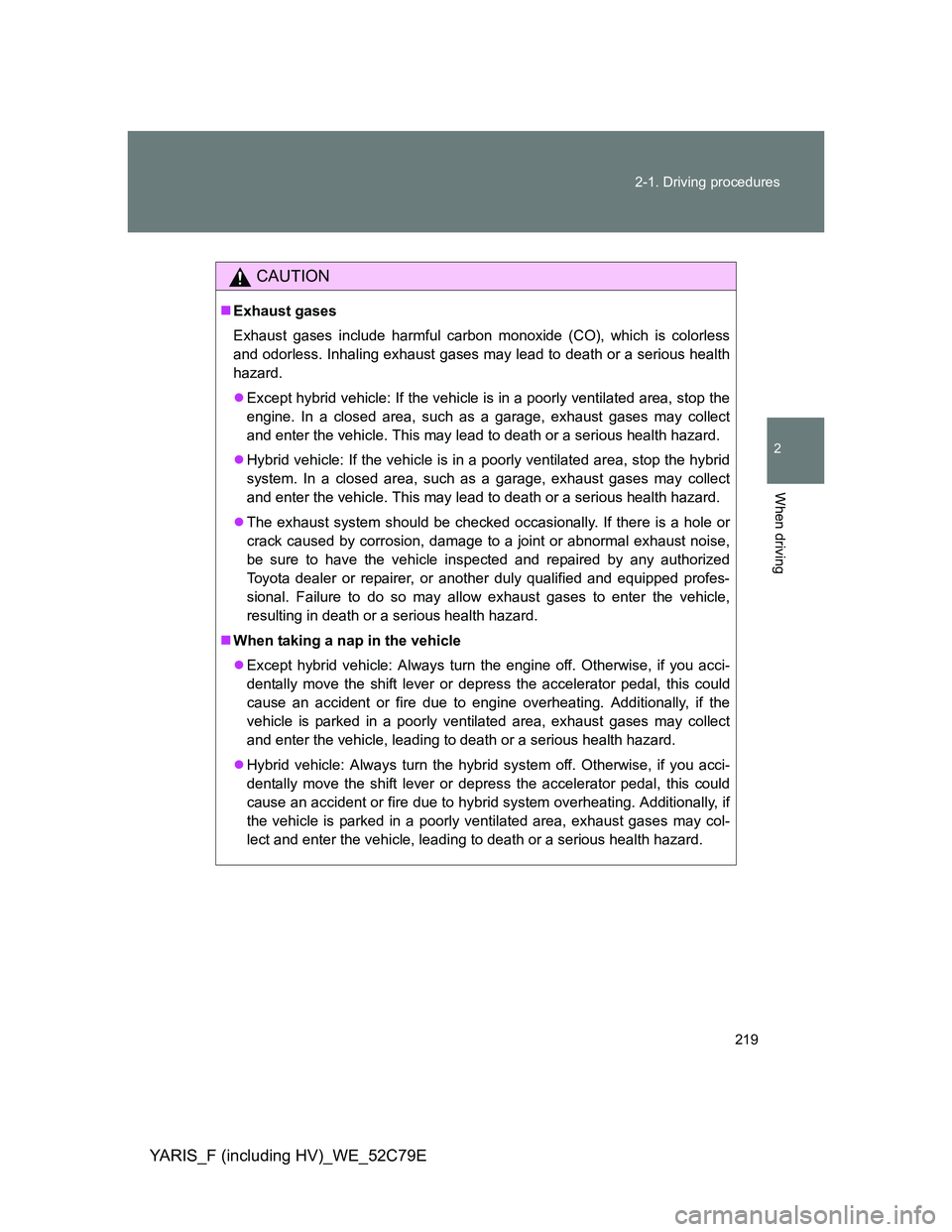
219 2-1. Driving procedures
2
When driving
YARIS_F (including HV)_WE_52C79E
CAUTION
Exhaust gases
Exhaust gases include harmful carbon monoxide (CO), which is colorless
and odorless. Inhaling exhaust gases may lead to death or a serious health
hazard.
Except hybrid vehicle: If the vehicle is in a poorly ventilated area, stop the
engine. In a closed area, such as a garage, exhaust gases may collect
and enter the vehicle. This may lead to death or a serious health hazard.
Hybrid vehicle: If the vehicle is in a poorly ventilated area, stop the hybrid
system. In a closed area, such as a garage, exhaust gases may collect
and enter the vehicle. This may lead to death or a serious health hazard.
The exhaust system should be checked occasionally. If there is a hole or
crack caused by corrosion, damage to a joint or abnormal exhaust noise,
be sure to have the vehicle inspected and repaired by any authorized
Toyota dealer or repairer, or another duly qualified and equipped profes-
sional. Failure to do so may allow exhaust gases to enter the vehicle,
resulting in death or a serious health hazard.
When taking a nap in the vehicle
Except hybrid vehicle: Always turn the engine off. Otherwise, if you acci-
dentally move the shift lever or depress the accelerator pedal, this could
cause an accident or fire due to engine overheating. Additionally, if the
vehicle is parked in a poorly ventilated area, exhaust gases may collect
and enter the vehicle, leading to death or a serious health hazard.
Hybrid vehicle: Always turn the hybrid system off. Otherwise, if you acci-
dentally move the shift lever or depress the accelerator pedal, this could
cause an accident or fire due to hybrid system overheating. Additionally, if
the vehicle is parked in a poorly ventilated area, exhaust gases may col-
lect and enter the vehicle, leading to death or a serious health hazard.
Page 220 of 704
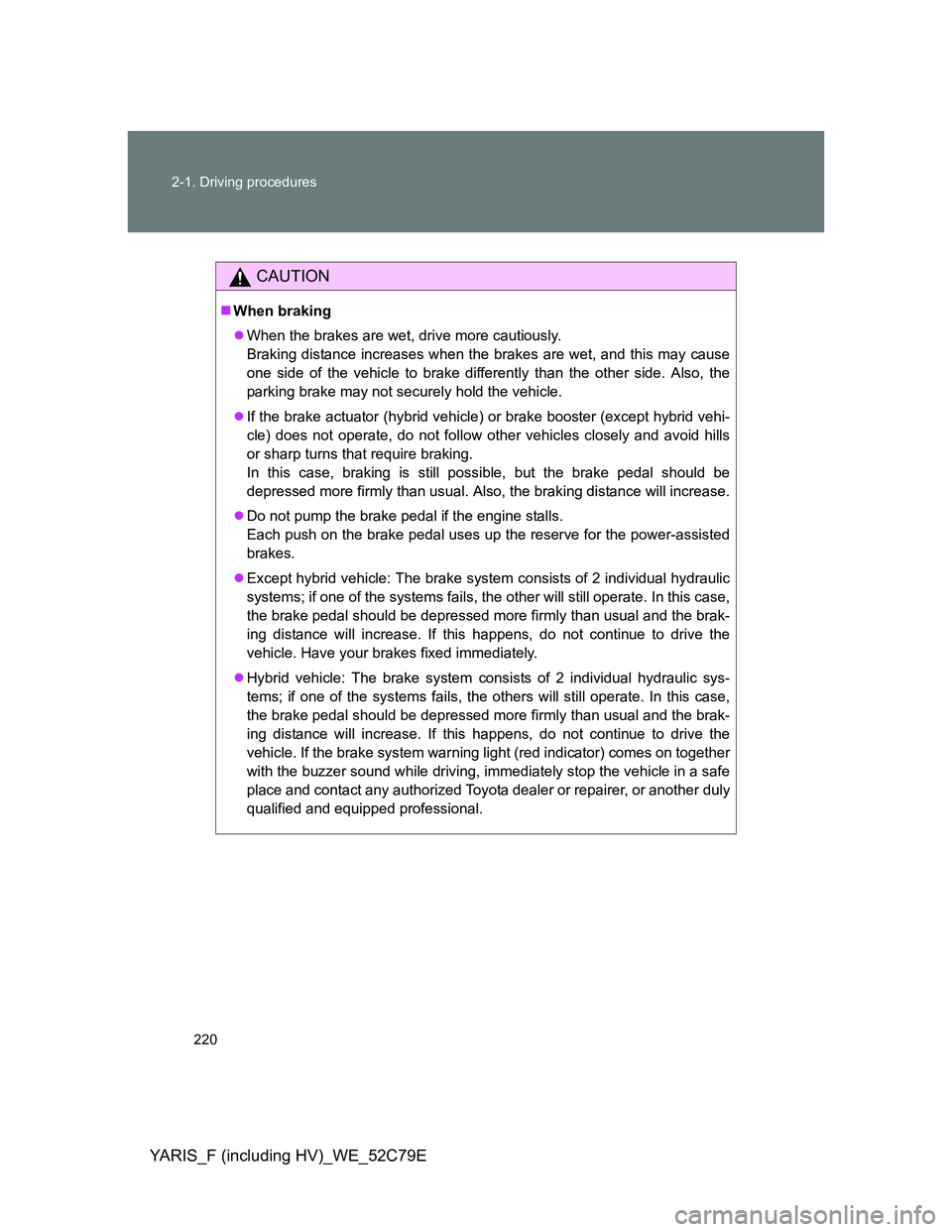
220 2-1. Driving procedures
YARIS_F (including HV)_WE_52C79E
CAUTION
When braking
When the brakes are wet, drive more cautiously.
Braking distance increases when the brakes are wet, and this may cause
one side of the vehicle to brake differently than the other side. Also, the
parking brake may not securely hold the vehicle.
If the brake actuator (hybrid vehicle) or brake booster (except hybrid vehi-
cle) does not operate, do not follow other vehicles closely and avoid hills
or sharp turns that require braking.
In this case, braking is still possible, but the brake pedal should be
depressed more firmly than usual. Also, the braking distance will increase.
Do not pump the brake pedal if the engine stalls.
Each push on the brake pedal uses up the reserve for the power-assisted
brakes.
Except hybrid vehicle: The brake system consists of 2 individual hydraulic
systems; if one of the systems fails, the other will still operate. In this case,
the brake pedal should be depressed more firmly than usual and the brak-
ing distance will increase. If this happens, do not continue to drive the
vehicle. Have your brakes fixed immediately.
Hybrid vehicle: The brake system consists of 2 individual hydraulic sys-
tems; if one of the systems fails, the others will still operate. In this case,
the brake pedal should be depressed more firmly than usual and the brak-
ing distance will increase. If this happens, do not continue to drive the
vehicle. If the brake system warning light (red indicator) comes on together
with the buzzer sound while driving, immediately stop the vehicle in a safe
place and contact any authorized Toyota dealer or repairer, or another duly
qualified and equipped professional.